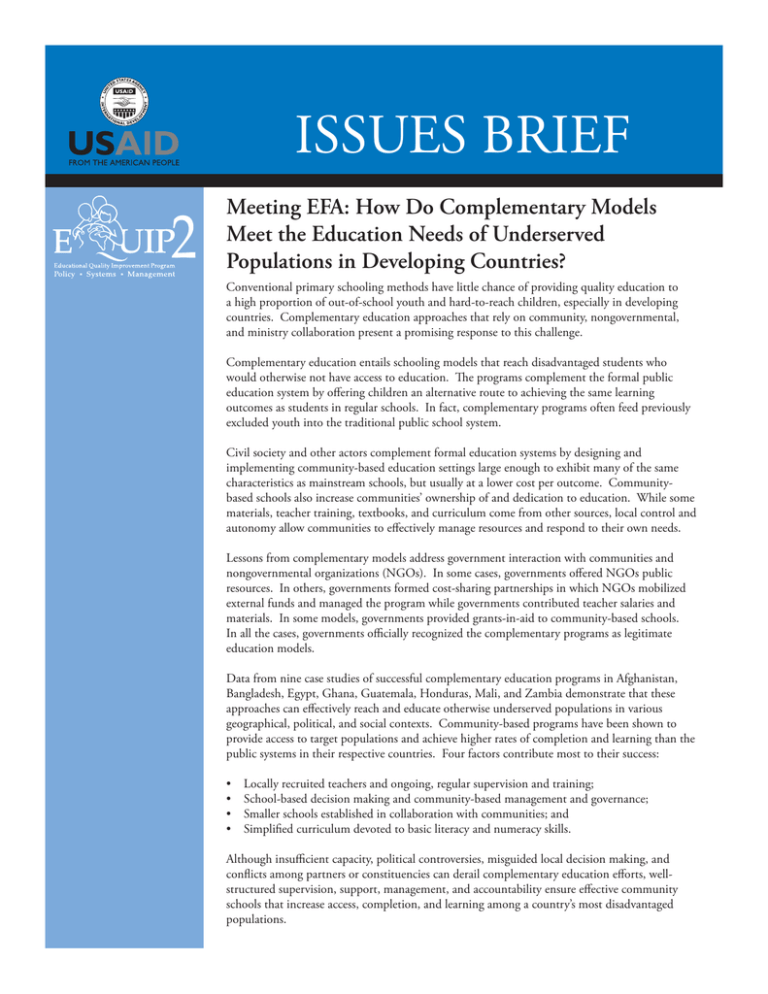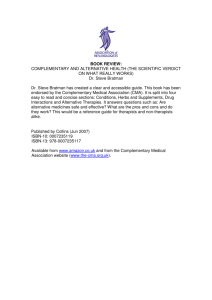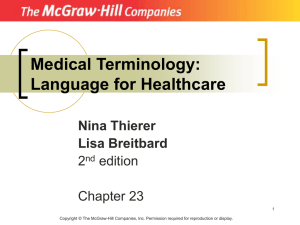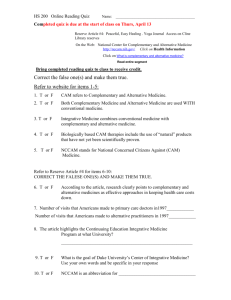ISSUES BRIEF
advertisement

ISSUES BRIEF Meeting EFA: How Do Complementary Models Meet the Education Needs of Underserved Populations in Developing Countries? Conventional primary schooling methods have little chance of providing quality education to a high proportion of out-of-school youth and hard-to-reach children, especially in developing countries. Complementary education approaches that rely on community, nongovernmental, and ministry collaboration present a promising response to this challenge. Complementary education entails schooling models that reach disadvantaged students who would otherwise not have access to education. The programs complement the formal public education system by offering children an alternative route to achieving the same learning outcomes as students in regular schools. In fact, complementary programs often feed previously excluded youth into the traditional public school system. Civil society and other actors complement formal education systems by designing and implementing community-based education settings large enough to exhibit many of the same characteristics as mainstream schools, but usually at a lower cost per outcome. Communitybased schools also increase communities’ ownership of and dedication to education. While some materials, teacher training, textbooks, and curriculum come from other sources, local control and autonomy allow communities to effectively manage resources and respond to their own needs. Lessons from complementary models address government interaction with communities and nongovernmental organizations (NGOs). In some cases, governments offered NGOs public resources. In others, governments formed cost-sharing partnerships in which NGOs mobilized external funds and managed the program while governments contributed teacher salaries and materials. In some models, governments provided grants-in-aid to community-based schools. In all the cases, governments officially recognized the complementary programs as legitimate education models. Data from nine case studies of successful complementary education programs in Afghanistan, Bangladesh, Egypt, Ghana, Guatemala, Honduras, Mali, and Zambia demonstrate that these approaches can effectively reach and educate otherwise underserved populations in various geographical, political, and social contexts. Community-based programs have been shown to provide access to target populations and achieve higher rates of completion and learning than the public systems in their respective countries. Four factors contribute most to their success: • • • • Locally recruited teachers and ongoing, regular supervision and training; School-based decision making and community-based management and governance; Smaller schools established in collaboration with communities; and Simplified curriculum devoted to basic literacy and numeracy skills. Although insufficient capacity, political controversies, misguided local decision making, and conflicts among partners or constituencies can derail complementary education efforts, wellstructured supervision, support, management, and accountability ensure effective community schools that increase access, completion, and learning among a country’s most disadvantaged populations. Meeting EFA: How do Complementary Models Meet the Education Needs of Underserved Populations in Developing Countries? Acknowledgements This paper was written for EQUIP2 by Joseph DeStefano (Center for Collaboration and the Future of Schooling), Audrey-marie Schuh Moore (Academy for Educational Development), David Balwanz (Academy for Educational Development), and Ash Hartwell (Education Development Center), 2006. A more detailed EQUIP2 Working Paper and nine EQUIP2 Case Studies are also available. EQUIP2: Educational Policy, Systems Development, and Management is one of three USAID-funded Leader with Associates Cooperative Agreements under the umbrella heading Educational Quality Improvement Program (EQUIP). As a Leader with Associates mechanism, EQUIP2 accommodates buy-in awards from USAID bureaus and missions to support the goal of building education quality at the national, sub-national, and cross-community levels. The Academy for Educational Development (AED) is the lead organization for the global EQUIP2 partnership of education and development organizations, universities, and research institutions. The partnership includes fifteen major organizations and an expanding network of regional and national associates throughout the world: Aga Khan Foundation, American Institutes for Research, CARE, Center for Collaboration and the Future of Schooling, East-West Center, Education Development Center, International Rescue Committee, Joseph P. Kennedy, Jr. Foundation, Michigan State University, Mississippi Consortium for International Development, ORC Macro, Research Triangle Institute, University of Minnesota, University of Pittsburgh Institute of International Studies in Education, Women’s Commission for Refugee Women and Children. For more information about EQUIP2, please contact: USAID Patrick Collins CTO EGAT/ED USAID Washington 1300 Pennsylvania Ave., NW Washington, DC 20532 Tel: 202-712-4151 Email: pcollins@usaid.gov AED John Gillies EQUIP2 Project Director 1825 Connecticut Ave., NW Washington, DC 20009 Tel: 202-884-8256 Email: equip2@aed.org Web: www.equip123.net This paper was made possible by the generous support of the American people through the United States Agency for International Development (USAID) under Cooperative Agreement No. GDG-A-00-03-00008-00. The contents are the responsibility of the Academy for Educational Development (AED) through the Educational Quality Improvement Program 2 (EQUIP2) and do not necessarily reflect the views of USAID or the United States Government.








